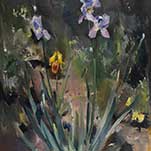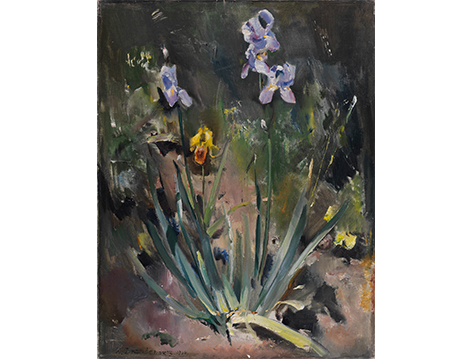



Wilhelm Ludger Brandenberg
威廉·路德·布兰登伯格
(1889-1975)
艺术家简介
Biography
威廉·卢德格尔·勃兰登伯格1889年12月22日生于埃森,1975年1月8日卒于克雷费尔德,是出自杜塞尔多夫艺术学院的德国新客观派画家。
1908年,卢德格尔进入杜塞尔多夫艺术学院学习绘画。著名画家威利·斯帕兹(Willy Spatz)、阿道夫·明泽尔(Adolf Münzer)、朱利叶斯·保罗·约翰尼斯(Julius Paul Junghanns)、路德维希·凯勒(Ludwig Keller)和阿道夫·曼臣(Adolf Maennchen)都曾是他的老师。他还曾跟随约翰尼斯出国深造。
1913年,卢德格尔成为杜塞尔多夫艺术家协会Malkasten的成员。第一次世界大战期间,他中断了艺术研究,并从1917年起担任某轻骑兵团的军官。两年后,他回到学校继续学习,成为了明泽尔的硕士研究生,并于当年完婚。
1921年,他完成了学业。然而毕业第二年他却迎来了人生低谷--他的妻子和父亲相继离开人世。这一年心力交瘁的卢德格尔搬回了克雷费尔德,并且直到1945年一直生活在父亲留下的住所。
所幸的是,卢德格尔并没有就此一蹶不振、放弃对绘画艺术的追求,直到20世纪40年代,他一直致力于运用印象派绘画技巧探索新客观派绘画的创作。1934-1944的十年间,卢德格尔担任了埃森福克旺德国工艺硕士学院的教师。
然而二战爆发前夕,1937年卢德格尔加入了德国社会主义工人党(NSDAP)。1945年,当第二次世界大战结束后不久,他的住所“Wilhelmshof”被英国军政府没收,近一百幅画作因此丢失。
据说卢德格尔曾在战后加入“下莱茵艺术家协会(NiederrheinischeKünstlergilde)”。卢德格尔的绘画作品题材丰富,包含静物、肖像,而风景作品则取材于工业场景、河流、城市景观以及日常的园林场景,但尤以静物绘画著名。
1920-1973年间,卢德格尔的作品曾在许多重要展览展出,如定期参展Malkasten艺术家协会的展览,多次参加杜塞尔多夫的大型艺术展览和慕尼黑的大型德国艺术展览。在他逝世以后,1976年他的作品被Paffrath画廊、杜塞尔多夫、HP画廊、Velbert-Langenberg等展出,2011年林恩城堡博物馆中心也展出了他的作品。
Wilhelm "Willi" Ludger Brandenberg (born December 22, 1889 in Essen, † January 8, 1975 in Krefeld) was a German painter of the Düsseldorf School and the New Objectivity.
Brandenberg, son of the coal dealer Wilhelm Georg Brandenberg (1866-1922), moved in 1892 with his family to Krefeld, where it brought the father to some fortune. In 1906 he went to Dusseldorf. After futile attempts, he was admitted to study at the Düsseldorf Art Academy in 1908. Willy Spatz, Adolf Münzer, Julius Paul Junghanns, Ludwig Keller and Adolf Maennchen were his teachers. With Junghanns he undertook study trips abroad. In 1913 he became a member of the Dusseldorf artist association Malkasten. During the First World War, he interrupted the study of art and served from 1917 as an officer in a hussar regiment. In 1919 he continued his studies and became a master student at Münzer. In 1919 he married. In 1921 he finished his studies. His wife died in 1922, and his father died the same year. This year he moved back to Krefeld-Bockum, where he lived until 1945 the paternal "Wilhelmshof", then a house on a neighboring property. In 1934 he became a teacher at the Folkwang master school (Meisterschule des Deutschen Handwerks) in Essen. This activity he exercised until 1944. In 1937 he joined the NSDAP. Shortly after the end of the war in 1945, the British military administration confiscated Brandenberg's residence, the "Wilhelmshof", whereby around one hundred of his paintings were lost. In the post-war period he is said to have become a member of the "Niederrheinische Künstlergilde".
Brandenberg created some still lifes, few portraits, especially landscapes, including many industrial images, river and city views and prosaic garden scenes in a style of New Objectivity influenced by Impressionist painting techniques, which he remained committed to well into the 1940s. Between 1920 and 1973, Brandenberg exhibited at many exhibitions, regularly at exhibitions of the artists' association Malkasten, at major Düsseldorf art exhibitions and at major German art exhibitions in Munich (1938, 1941, 1942, 1943). Posthumously, his works were on exhibitions in the years 1976 (gallery Paffrath, Dusseldorf, and HP gallery, Velbert-Langenberg) and 2011 (Museum Center Burg Linn) to see.
艺术家作品
ART WORKS








